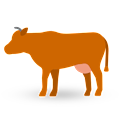Schulter
(Falsches filet, Schaufel)
In German butchery, schulter refers to the shoulder of the cow. Positioned at the front of the animal, it is composed of multiple muscles and a significant amount of connective tissue due to the regular movement of the cow's front legs. Because of the continuous motion in this part of the animal, schulter tends to be tougher than some other cuts.
This regular activity, however, endows the meat with a rich, beefy flavor and a good marbling of fat throughout the muscles. The inherent toughness of schulter means it's best suited for slow-cooking methods. When braised, stewed, or slow-roasted, the connective tissue breaks down, rendering the meat tender and flavorful.
In German cuisine, schulter might be used in dishes like goulash or other slow-cooked stews. To fully enjoy the schulter, it should be slow-cooked to allow the collagen-rich connective tissues to break down. Read more
Braising with aromatic vegetables, herbs, and a flavorful liquid (like broth, wine, or beer) yields especially delightful results. Before this slow cooking, searing the meat can add an extra layer of flavor due to the Maillard reaction. The hearty beef flavor of schulter is enhanced when paired with robust ingredients.
Root vegetables, grains, and legumes are natural companions. Additionally, seasonings like garlic, onion, rosemary, thyme, and bay leaves work well. Schulter also benefits from rich sauces, often derived from the very liquids it's cooked in.



